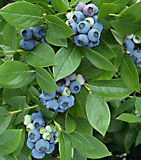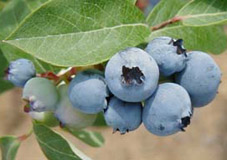 Sweet, juicy blueberries are rich in natural pro-anthocyanin pigment anti-oxidants. These tiny, round blue-purple berries have long been attributed to the longevity and wellness of indigenous people living around subarctic regions in the Northern hemisphere. Botanically, it is a deciduous shrub belonging within the family of Ericaceae, in the genus, Vaccinium. Broadly, vaccinium species are classified according to their growth habit as high-bush and low-bush berries.
Sweet, juicy blueberries are rich in natural pro-anthocyanin pigment anti-oxidants. These tiny, round blue-purple berries have long been attributed to the longevity and wellness of indigenous people living around subarctic regions in the Northern hemisphere. Botanically, it is a deciduous shrub belonging within the family of Ericaceae, in the genus, Vaccinium. Broadly, vaccinium species are classified according to their growth habit as high-bush and low-bush berries.
- High-bush blueberry (Vaccinium corymbosum) is a highly branched, erect deciduous shrub with rich foliage. It grows upto 10-12 feet tall in cultivated orchards and bears clusters of small, cream-white flowers during spring, which subsequently develop into tiny berries after about two months. In the wild, high bush-
 blueberry is found on the edges of marshes, lakes, ponds, and streams. Rabbiteye blueberry (Vaccinium virgatum, also known as V. ashei.) is a medium-sized shrub grows naturally in South Eastern parts of USA.
blueberry is found on the edges of marshes, lakes, ponds, and streams. Rabbiteye blueberry (Vaccinium virgatum, also known as V. ashei.) is a medium-sized shrub grows naturally in South Eastern parts of USA. - Low-bush blueberry (Vaccinium angustifolium) is a short, erect plant that grows about one-two feet in height and spread through underground rhizomes. Under the cultivated farms, it is grown as two-year cycle crop since the whole plant is either mowed down or burnt to allow new shoots that appear only during the next season.
Both species require well-drained sandy, acidic soil to flourish. The shrub prefers open sunny conditions and intolerant of shade. In general, the berries can be ready for harvesting when they turn completely blue from green-pink, become soft, juicy, and sweeter. Traditionally, bluberries gathered by handpicking, and therefore, require intense labor. Soon after the berries separated from the shrub, they sorted out and transported to cold facility for storage.
Health benefits of blueberries
- Blueberries are very low in calories. 100 g fresh berries carry just 57 calories. Nonetheless, they possess notable health benefiting plant-nutrients such as soluble dietary fiber, minerals, vitamins, and pigment anti-oxidants that contribute immensely towards optimum health and wellness.
- Blueberries are among the highest anti-oxidant value fruits. The ORAC value of 100 g fresh blueberry is 5562 TE (Trolex equivalents). Their antioxidant value largely comes from poly-phenolic anthocyanidin compounds such as chlorogenic acid, tannins, myricetin, quercetin and kaempferol.
- Additionally they compose of other flavonoid anti-oxidants such as carotene-ß, lutein and zea-xanthin.
- Altogether, the phyto-chemical compounds in the blueberry help rid off harmful oxygen-derived free radicals from the human body, and thereby, protect it against cancers, aging, degenerative diseases, and infections.
- Further, research studies suggest that chlorogenic acid in these berries help lower blood sugar levels and control blood-glucose levels in type-II diabetes mellitus condition.
- Fresh berries carry small amount of vitamin C, vitamin A and vitamin E. Altogether, these vitamins work as potent anti-oxidants which help limit free radical mediated injury to the body.
- The berries also carry a small amount of B-complex group of vitamins such as niacin, pyridoxine, folates and pantothenic acid. They are very good in vitamin B-6, niacin, riboflavin, pantothenic acid and folic acid. These vitamins are acting as co-factors that help in metabolism of carbohydrates, protein, and fats.
- Furthermore, they contain a good amount of minerals like potassium, manganese, copper, iron and zinc. Potassium is an important component of cell and body fluids that helps controlling heart rate and blood pressure. Manganese is used by the body as a co-factor for the antioxidant enzyme, superoxide dismutase. Copper is required for the production of red blood cells. Iron is required for red blood cell formation.
Selection and storage
In the United States, blueberries can be readily available in the markets year around. However, fresh wild berries are at their best from June until August when their harvest season begins in Michigan and Maine in USA and Quebec province in Canada. In the stores, look for fresh berries that are firm, plump, smooth-skinned, with a silver-gray surface bloom. Buy deep purple-blue to blue-black berries. Avoid soft or shriveled, over-handled, bruised berries and those with signs of mold and of old stock. Once at home, place the berries in a plastic or zip pouch and store inside the refrigerator set at high relative humidity. Stored thus, they stay well for up to a week.
Preparation and serving tips
Blueberries are sweet and juicy, stain teeth and tongue deep blue. Trim away any stems and leaves if you have purchased berries directly from the local farmer. They are better eaten fresh after washing in cold water. If taken out from the cold storage, place them in a bowl of water to bring them back to normal room temperature, which enriches their taste and palatability. Gently pat dry using a moisture absorbent cloth/paper and enjoy! Here are some serving tips:
- Traditionally, blueberries have been part of food culture of Native Americans.
- While fresh berries eaten as they are like in table grapes, dried ones added to soup, stews, and to sweeten venison meat.
- Dry bluberries are one of the most preferred berries in the preparation of muffins, pies, and cheesecakes.
- They are also favorite addition in fruit salads, fresh fruit-tarts, ice-creams, etc.
- They can also be emlpoyed to make juice, sauce, jellies, and jams.
Safety profile
Blueberries may oftentimes cause serious allergic reactions in sensitized individuals. Often, these kinds of reactions occur because of possible cross-reactions to other berries (strawberry), pollen or weed allergies. Some of the most common symptoms of blueberry allergy may include swelling and redness of mouth, lips and tongue, eczema, hives, skin rash, headache, runny nose, itchy eyes, wheezing and gastrointestinal disturbances. Individuals who suspect allergy to these fruits may want to avoid eating them.
